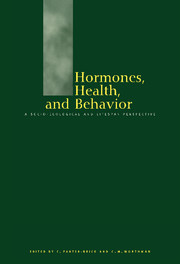Book contents
- Frontmatter
- Contents
- Contributors
- 1 Contributions of biological anthropology to the study of hormones, health, and behavior
- 2 Hormonal correlates of personality and social contexts: from non-human to human primates
- 3 Epidemiology of human development
- 4 Family environment, stress, and health during childhood
- 5 Work and hormonal variation in subsistence and industrial contexts
- 6 Reproductive ecology and reproductive cancers
- 7 Diet, hormones, and health: an evolutionary–ecological perspective
- 8 Modernization, psychosocial factors, insulin, and cardiovascular health
- Index
2 - Hormonal correlates of personality and social contexts: from non-human to human primates
Published online by Cambridge University Press: 29 January 2010
- Frontmatter
- Contents
- Contributors
- 1 Contributions of biological anthropology to the study of hormones, health, and behavior
- 2 Hormonal correlates of personality and social contexts: from non-human to human primates
- 3 Epidemiology of human development
- 4 Family environment, stress, and health during childhood
- 5 Work and hormonal variation in subsistence and industrial contexts
- 6 Reproductive ecology and reproductive cancers
- 7 Diet, hormones, and health: an evolutionary–ecological perspective
- 8 Modernization, psychosocial factors, insulin, and cardiovascular health
- Index
Summary
Introduction
Primatologists have long been fascinated by the dominance hierarchies of their study subjects. A number of early researchers attributed what was, in retrospect, an inappropriate power to an animal's rank in predicting its reproductive success, degree of attractivity to the opposite sex, willingness to defend other individuals against predators, and so on. Many of these misconceptions were clarified with the emergence of new theoretical constructs, such as the recognition of female choice, of alternative competitive strategies among individuals, or the importance of kin-based models of natural selection. In the wake of some of this early overenthusiasm for the explanatory power of rank, a number of individuals questioned the validity of the rank concept – whether such dyadic assymetries actually occur under most ecological conditions (e.g., Rowell, 1974), and whether the animals themselves “understood” rank in a meaningful way (as opposed to a hierarchy merely being an artificial construct projected by human observers) (e.g., Bernstein, 1981).
Despite these critiques, dominance hierarchies have remained close to the hearts of many primatologists, and are thought to occur among many species and to provide a meaningful way to understand individual differences in the experiences and quality of life of non-human primates. Out of this has emerged a considerable number of studies built around the premise that rank in such hierarchies helps to explain individual differences in the physiology of primates, with important implications for understanding disease patterns and differential fitness.
- Type
- Chapter
- Information
- Hormones, Health and BehaviourA Socio-ecological and Lifespan Perspective, pp. 18 - 46Publisher: Cambridge University PressPrint publication year: 1998
- 5
- Cited by



